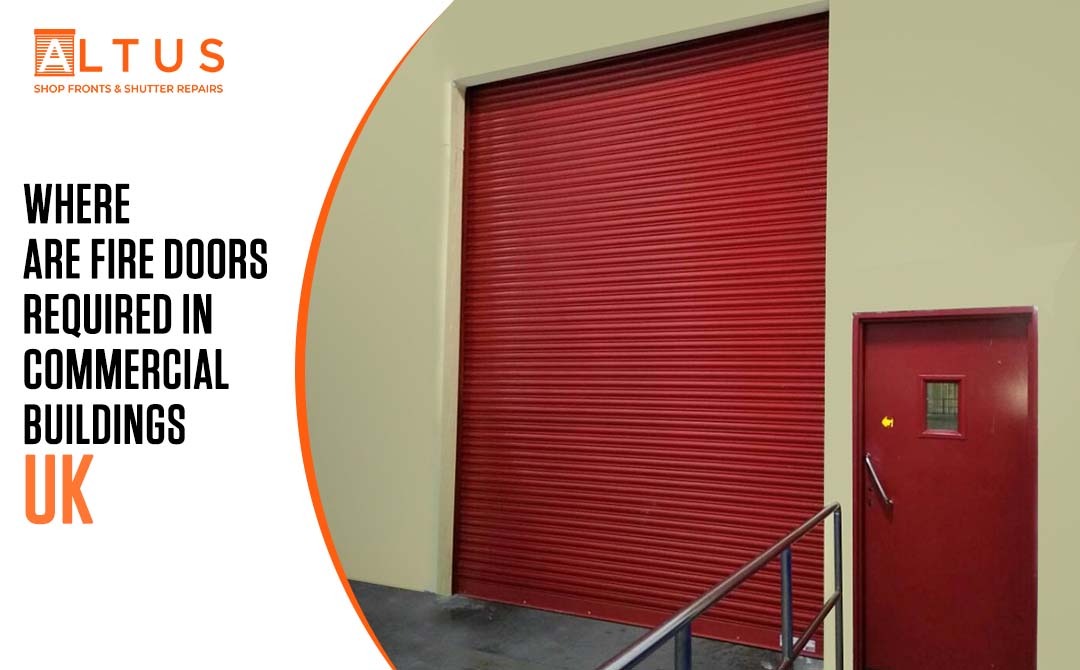In the complex field of managing commercial properties in the UK, keeping buildings and people safe is extremely important. Among the many safety steps, fire doors are key. They play a big role in stopping fire and smoke from spreading. This makes them more than just a rule to follow; they are a fundamental part of keeping commercial buildings safe.
Altus Shutters Repairs is a leading provider of premium shutter solutions and repair services across the UK. Specialising in both traditional and contemporary designs, our expert team delivers bespoke installations tailored to each client’s specific needs. With a commitment to quality and customer satisfaction, we offer durable, aesthetically pleasing shutters, ensuring functionality and style.
Understanding the Legal Framework For Fire-rated Doors
The Regulatory Reform (Fire Safety) Order 2005 is indeed a pivotal piece of legislation governing fire safety in the UK. It applies universally to all non-domestic premises, encompassing commercial buildings among others. This law mandates the designation of a ‘responsible person’—typically the premises’ owner, employer, or manager—to undertake comprehensive fire risk assessments and to put into place necessary fire safety precautions.
A critical component of these safety measures includes the installation of fire-rated doors in specified areas, aimed at mitigating the spread of fire and smoke, thereby enhancing the overall safety and security of the building and its occupants. This legal framework underscores the importance of maintaining stringent fire safety standards to protect lives and property.
Key Locations for Fire Door Installation
- Exit Passageways:
According to building codes, a crucial criterion for the installation of commercial doors, specifically fire-rated metal doors, is along designated exit passageways. These are essential corridors and stairways utilised during evacuations, ensuring a safe route out of the building during emergencies. - Building Compartmentalisation:
Code requirements emphasise the importance of compartmentalisation within a structure to curb the spread of fire. This involves separate buildings into sections with fire-rated doors, a measure that is vital in areas separating different fire zones within the frame size assembly. - High-Risk Areas:
Commercial doors, particularly fire-rated metal doors, are mandated in areas prone to moderate and severe fire exposure, such as kitchens and boiler rooms. These doors serve to isolate these high-risk zones from the rest of the building, adhering to safety regulations and ensuring a safe product is maintained. - Mixed-Use Facilities:
For building subject to varied usage, integrating retail and residential spaces, building codes require the installation of fire-rated doors to delineate and protect these separate areas from moderate fire exposure. This is crucial for preventing fire spread across different sections, and aligning with safety regulations. - Fire Escape Access Points:
The placement of fire-rated doors at access points to fire escapes is a stipulated code requirement. These installations are vital for preserving the exit passageway’s integrity, ensuring it remains unobstructed by smoke or flames, thus facilitating a maximum rise in safety during evacuations. - Vertical Conduits and Service Areas:
Elevator shafts and service ducts, acting as potential vertical pathways for fire and smoke, must be fitted with fire-rated doors according to building codes. This high-rise buildings strategy is one of the common applications designed to prevent the vertical transmission of fire, ensuring both the exterior wall and the entire building frame assembly maintain structural integrity and safeguard occupants.
Specifications and Standards for Fire Doors
Fire doors must meet specific standards to be effective. They are rated by their fire resistance duration, typically ranging from FD30 (30 minutes) to FD120 (120 minutes). The selection of the appropriate fire resistance level depends on the building’s size, use, and the fire risk assessment outcomes.
Moreover, fire doors must be fitted with appropriate hardware, including self-closing devices, intumescent seals, and fire-rated door furniture. Regular maintenance and inspections are also required to ensure that they remain effective over time.
The Importance of Compliance and Documentation
Compliance with the relevant standards and regulations is not just a matter of legal necessity; it is a critical aspect of building management that ensures the safety of occupants and assets. Keeping thorough documentation of fire risk assessments, the installation and maintenance of fire doors, and any other fire safety measures is crucial. This documentation not only serves as evidence of compliance but also as a guide for ongoing property management.
The Role of Professional Advice
Given the complexity of fire safety regulations and the technical specifications for fire doors, seeking professional advice is recommended. Fire safety consultants and specialists can provide invaluable insights into the specific requirements for your premises, ensuring that you not only comply with the law but also maximise the safety of your building and its occupants.
Conclusion
In conclusion, the implementation of fire-rated doors within commercial buildings is a critical aspect of ensuring safety and compliance with building codes. From the maximum size of doors designed to act as smoke barriers to the specific fire-protection ratings such as 1-1/2-hour and 3/4-hour fire doors, each specification plays a vital role.
Particularly, the 1/3-hour (20-minute) rated doors offer a foundational level of protection, suitable for areas requiring moderate shielding against fire and smoke.
Meanwhile, 1-1/2-hour fire doors provide enhanced security in more critical areas, offering substantial resistance. Adhering to these specifications not only enhances safety but also ensures a coherent approach to fire and smoke management in commercial environments.




